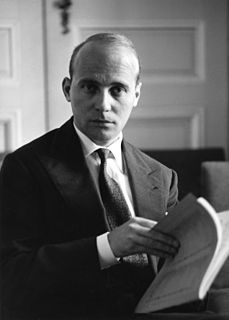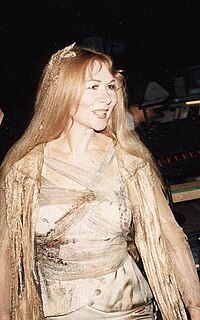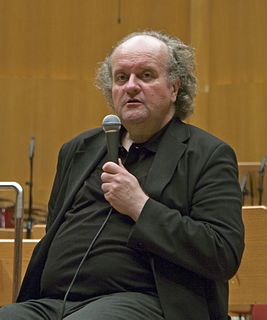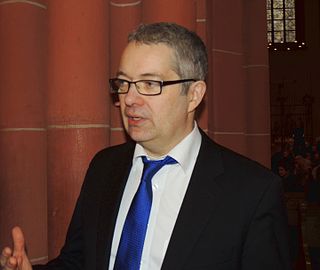
Helge Burggrabe (born 17 June 1973) in Magstadt is a German composer, recorder player, stage designer and seminar leader.

Helge Burggrabe (born 17 June 1973) in Magstadt is a German composer, recorder player, stage designer and seminar leader.
As a child, Burggrabe lived for several years in Burma (Myanmar). Later he had lessons with Hans-Jürgen Hufeisen, among others, and studied at the Hochschule für Musik und Theater Hamburg with Evi Pfefferle-Darmstadt and Peter Michael Hamel. His diploma thesis dealt with Die Proportionsverhältnisse und ihre Widerspiegelung in Musik und Architektur am Beispiel der Kathedrale von Chartres. (Proportional relationships and their reflection in music and architecture using the example of Chartres Cathedral).
Since 1993, Burggrabe has performed throughout Europe with his own concert series, especially in Germany, France, Switzerland and Austria. Burggrabe works in various ensembles, including "Duo3" with the pianist Christof Fankhauser and the duo "Resonatus" with the singer Victoria Walker. [1]
Since the mid-1990s, several projects have dealt with the symbol and cultural history of the labyrinth as well as with the Chartres Cathedral, where Burggrabe's Marian oratorio Stella Maris was premiered in 2006. As a stage designer and landscape artist, Burggrabe built several labyrinths, including two permanent ones in northern Germany.
Burggrabe's concert programmes are usually thematically oriented and often combine music with various other arts, for example poetry], with architecture, with photography and live painting, with dance performances.
Burggrabe's compositions can be roughly divided into two areas. In the joint works with Christof Fankhauser, his music is primarily characterised by a novel combination of classical music and jazz, often interspersed with improvisational elements that also reveal influences from folk music, klezmer and pop music. Examples of this are the concertante composition Rose - Hommage an einen Mythos (2003) and the children's music theatre project Kinderplanet/Planet Bunterkunt (1999 and 2006 respectively) as well as a joint tour with the crossover cellist Jost H. Hecker from the Modern String Quartet (2008).
Since 2004, Burggrabe's preoccupation with Chartres Cathedral and with philosophical and spiritual themes has been increasingly reflected in his music. For the project Resonatus, mainly performed in Romanesque churches, Burggrabe combined elements of Gregorian chant and his own compositions for flute, voice and monochord. Burggrabe wrote the libretto with the Benedictine monk Anselm Grün, with whom he later also published the joint book and CD project Zeiten der Stille.

Burggrabe achieved his own musical language with the Marian oratorio Stella Maris, [2] [3] 8 September 2006. Inspired by the colouring of the windows in Chartres, it is also called the Blue Oratorio In it, Burggrabe, who is also responsible for the libretto, combines texts handed down from Fulbert of Chartres with modern poetry and, on the musical side, medieval compositions with a very contemporary musical aesthetic (influenced among others by György Ligeti). [4]
Participants in the premiere, which was conceived as a "concertante Gesamtkunstwerk for music, space, language, water and light", included others Graciela de Gyldenfeldt (soprano), Hiam Abbass (narration), Emmanuelle Bertrand (cello), Patrick Delabre (organ), the Harvestehuder Kammerchor and a choir from Chartres as well as Michael Batz (light installations) and Alexander Lauterwasser (WaterSoundProjections). The overall musical direction was by Claus Bantzer, Burggrabe himself was responsible for choreography and staging and played the flute parts.
The creation and premiere of the oratorio were documented in a film by NDR, which was first broadcast on Arte in March 2007.
The German premiere also took place in September 2006 in the St. Johannis Harvestehude Hamburg church. After two performances in autumn 2007 in the Maria, Königin des Friedens at Neviges, the largest performance to date took place in early May 2008 in the packed Cologne Cathedral. The new cathedral window by Gerhard Richter played an important role in the production there. The speaking role of Maria was taken over by the actress Iris Berben in the German-language concerts.

A new spiritual work by Burggrabe was premiered in May 2008. The libretto for Jehoshua - Oratorio of the Incarnation was written by the theologian Kurt Dantzer and consists of biblical texts and Psalms. The focus is on the life and work of Jesus Christ, the artistic starting point being the vowels I-E-O-U-A contained in his Hebrew name Jehoshua. The core pieces of the chapters are stories from the Gospels: Jesus heals a blind man, Jesus meets tax collectors, three women and teaches people with the parable of the Good Samaritan.
Musically, the combination of solo clarinet (in the premiere Johannes Peitz), cello, percussion and chamber orchestra as well as solo vocals (soprano, alto, tenor) and chamber choir is the focus of this commissioned work, which was created under the patronage of the then Prime Minister of Lower Saxony Christian Wulff. A painter contributed live calligraphies.
The Neue Presse Hanover wrote of the premiere: "Burggrabe's music has the seriousness and sublimity of church music by Johann Sebastian Bach. Fugue-like chorales and arias lean towards the style of the father of church music. At the same time, Burggrabe manages the balancing act to modernity and provides goosebumps with meditative choral pieces and promising, sometimes jubilant, sometimes lamenting solo arias." The Hannoversche Allgemeine Zeitung placed Jehoshua musically between John Rutter and Benjamin Britten.
The work Lux in Tenebris (Light in the Darkness) was commissioned on the occasion of the 1200th anniversary of the Diocese of Hildesheim. The libretto for the two-hour work is a joint work by Helge Burggrabe, Reinhard Göllner and Angela Krumpen. All four choirs at the Hildesheim Cathedral were involved in the performance: the cathedral choir, chamber choir, girls' choir and Schola. The premiere took place with four performances on 14-17 May 2015. Participants in the premiere were Martina Gedeck (recitation), ElbtonalPercussion , Geraldine Zeller (soprano), Anne Bierwirth (alto), Manuel König (tenor), KMD Helmut Langenbruch (organ), string quartet, wind trio of the Hildesheim Cathedral Music conducted by Cathedral Music Director Thomas Viezens and Cathedral Cantor Dr. Stefan Mahr; light and video art: Michael Suhr and media.plus X.
An oratorio is a large musical composition for orchestra, choir, and soloists. Like most operas, an oratorio includes the use of a choir, soloists, an instrumental ensemble, various distinguishable characters, and arias. However, opera is musical theatre, while oratorio is strictly a concert piece – though oratorios are sometimes staged as operas, and operas are sometimes presented in concert form. In an oratorio the choir often plays a central role, and there is generally little or no interaction between the characters, and no props or elaborate costumes. A particularly important difference is in the typical subject matter of the text. Opera tends to deal with history and mythology, including age-old devices of romance, deception, and murder, whereas the plot of an oratorio often deals with sacred topics, making it appropriate for performance in the church. Protestant composers took their stories from the Bible, while Catholic composers looked to the lives of saints, as well as to Biblical topics. Oratorios became extremely popular in early 17th-century Italy partly because of the success of opera and the Catholic Church's prohibition of spectacles during Lent. Oratorios became the main choice of music during that period for opera audiences.

Das Floß der Medusa is a secular oratorio by the German composer Hans Werner Henze. It is regarded as a seminal work in the composer's political alignment with left-wing politics.

The Book with Seven Seals is an oratorio in German by the Austrian composer Franz Schmidt, on themes from the biblical Book of Revelation of Saint John. It was completed in 1937 and first presented in 1938 in Vienna.

Ortrun Wenkel is a German operatic contralto. She notably portrayed the role of Erda in the Bayreuth Jahrhundertring in 1976 and was awarded a Grammy Award as a Principal Soloist in 1983.

Hartmann von An der Lan-Hochbrunn, O.F.M., was an Austrian Friar Minor and Catholic priest, who worked as a composer, organist and conductor.
Fritz Werner was a German choral conductor, church music director, conductor, organist and composer. He founded the Heinrich-Schütz-Chor Heilbronn in 1947 and conducted it until 1973.

Der Tod Jesu is an oratorio libretto by Karl Wilhelm Ramler. In its setting by Carl Heinrich Graun in 1755, it was the most often performed Passion of the 18th century in Germany.

Das Labyrinth oder Der Kampf mit den Elementen. Der Zauberflöte zweyter Theil is a "grand heroic-comic opera" in two acts composed in 1798 by Peter von Winter to a German libretto by Emanuel Schikaneder. The work is in the form of a Singspiel, a popular form that included both singing and spoken dialogue. The opera is a sequel of Mozart's The Magic Flute.

L'arpa festante is a German chamber orchestra, specializing in the revival and performance of unknown works, especially from the Baroque era. It was established in Munich in 1983 by Michi Gaigg, who also led the ensemble as concertmaster until 1995. The ensemble takes its name from Giovanni Battista Maccioni's dramatic cantata L'arpa festante which was first performed in 1653, inaugurating what was to become the Bavarian State Opera.

Lawrence Zazzo is an American countertenor. His repertoire includes roles in many Baroque operas and oratorios, as well as works of the 20th century. He lives in England.

Die Hamletmaschine is an opera composed by Wolfgang Rihm to a German-language libretto based on Heiner Müller's 1977 play of the same name. The libretto, subtitled Musiktheater in 5 Teilen, was written by the composer. The opera was composed between 1983 and 1986 and premiered on 30 March 1987 at the Nationaltheater Mannheim.

Peter Reulein is a German composer, organ improviser, academic teacher and church musician, from 2000 at the church Liebfrauen in Frankfurt am Main. In 2016 he composed for the Catholic Diocese of Limburg the Franciscan oratorio Laudato si'.

Laudato si' is an oratorio composed in 2016 by Peter Reulein on a libretto by Helmut Schlegel. Subtitled Ein franziskanisches Magnificat, it includes the full Latin text of the Magnificat, expanded by writings of Clare of Assisi, Francis of Assisi and Pope Francis. The composer set it for five soloists, children's choir, Choralschola, mixed choir, symphony orchestra and organ. It was published in 2016 by the Dehm Verlag, and was premiered on 6 November 2016 at the Limburg Cathedral, conducted by the composer.
Ulrike Sonntag is a German operatic soprano and academic voice teacher at the Staatliche Hochschule für Musik und Darstellende Kunst Stuttgart. She was previously a member of the Staatstheater Stuttgart, Vienna State Opera, and other ensembles, and has performed in operas and concerts, and taught masterclasses, in several countries. Among her recordings are rarely performed oratorios by Fanny Hensel and Paul Hindemith.
Günter Neubert is a German composer and tonmeister.
Bruder Martin is an oratorio composed by Thomas Gabriel to a libretto in German by Eugen Eckert. The work in seven scenes and a prologue is based on the life of Martin Luther. It was written for the 500th anniversary of the Reformation in 2017. The composition is set for narrator, soloists, mixed choir, band and orchestra, and includes both Luther hymns and pop ballads. Bruder Martin was premiered open air in Tecklenburg on 17 September 2017, with the performers dressed in period costumes. It was published by Strube Verlag.
Helge Jörns is a German composer and music educator.
Wilfried Hiller is a German composer. He became known above all for his stage works for families, children and young people.
Anne Bierwirth is a German contralto, focused on concerts and recordings of sacred music, appearing internationally. Besides the standard repertoire such as Bach's Christmas Oratorio, she has explored rarely performed Baroque music such as Bach's St Mark Passion and Reinhard Keiser's Passion oratorio Der blutige und sterbende Christus.
The Harvestehuder Kammerchor is a mixed choir from Hamburg, which has existed since 1980.